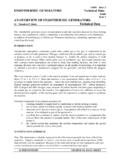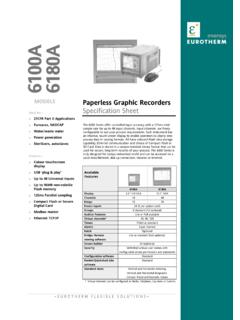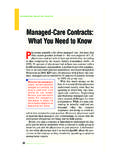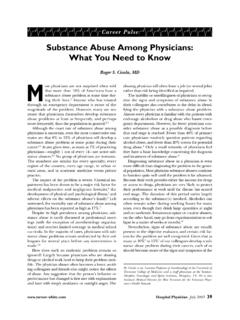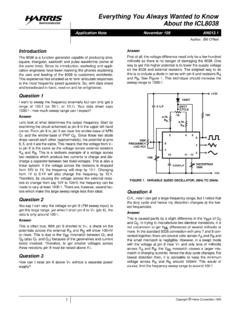Transcription of WHAT YOU SHOULD KNOW ABOUT SCR POWER …
1 WHAT YOUSHOULD KNOWABOUT SCRPOWERCONTROLLERS"What You SHOULD know ABOUT SCR POWER Controllers" was written as a practical guide to the selection and successfulapplication of SCR controllers. As such, it is not meant as a comprehensive discussion of POWER controllers and theirfunctions. If you require more in-depth information on this subject, please contact us at:Control Concepts, Worldwide by , GA USAP hone:+1-770-840-9811 Fax:+1-770-840-7514 WATS: 800-303-4705 Copyright, Control Concepts, Inc., 1988, 1992, 1993, 1995, 2000, 2002160 AMP SINGLE PHASE SCR CONTROLLER 425 AMP THREE-PHASE SCR INTRODUCTION TO SCR POWER CONTROLS ince the development of SCR POWER controllers in thelate 1950 s, the POWER handling capabilities of SCR s(silicon controlled rectifiers) have advanced from a fewhundred watts to many megawatts.
2 So, too, the use ofSCR POWER controllers in industrial applications hasincreased dramatically and they are now used in almostevery major MAJOR ADVANTAGESSCR POWER controllers provide a relatively economicalmeans of POWER control. SCR POWER controllers costless and are more efficient than saturable core reactorsand variable transformers. Compared to contactors,SCR POWER controllers offer a much finer degree ofcontrol and do not suffer from the maintenance problemsof mechanical devices. Features and benefits of SCRpower controllers over other forms of control include:High reliabilityBecause the SCR POWER controller is a solid-statedevice, there are no inherent wear-out modes. Thus,they provide virtually limitless and trouble free resolutionPower, current or voltage can be controlled from zero to100% with infinite resolution.
3 This capability allowsextremely accurate, stepless control of the fast responseThe SCR controller can switch load POWER on and offextremely fast providing the means to respond rapidly tocommand changes, load changes and POWER supplychanges. This feature allows the control of fast respondingloads and eliminates the negative effects of variations inload or supply voltages that can occur with other typesof control parametersThe SCR POWER controller can control the average loadvoltage, the RMS value of the load voltage, the RMS orthe average load current or load POWER . It can alsoprovide useful features such as current and voltagelimiting. The ability to control the desired parameter asa function of a command signal and to incorporatelimiting features is not normally available with othertypes of maintenanceBecause they are solid state there are no moving partsto wear out or replace.
4 Therefore, the routine replacementrequired in some forms of control is GENERAL DESCRIPTIONB asically, an SCR POWER controller consists of thefollowing: semiconductor POWER devices (SCR s and Diodes) a control circuit normally referred to as the firingcircuit a means to dissipate the heat generated from thesemiconductor devices and protective circuits (fuses and transientsuppressors).Figure SCR symbolFigure AC "Back to Back" SwitchSCR ModulesSCR modules are assemblies in which the SCR s arecontained in a plastic enclosure with an electricallyisolated mounting plate. SCR modules are becomingincreasingly popular and modules containing a variety ofSCR configurations are available. They are easy andinexpensive to mount to a heatsink, they typically havelarge surge current ratings and they provide electricalisolation, allowing multiple modules to be mounted on acommon heat CIRCUITThe electronic circuit controls the operation of theSCR s such that the desired energy applied to the loadis proportional to the command tasks of the circuit include:Timing: It is imperative, particularly in applicationsinvolving inductive loads such as transformers, that noDC be applied to the load.
5 For the reasons describedunder Trans-Guard ( ), DC components can alsocause supply transformers to over heat. This requiresthat the ON time of the back-to-back SCR s be exactlyequal. Modern circuits use sophisticated digital phaselock loop techniques which are immune to the electricalnoise and varying voltages that are often found inindustrial Isolation: The command signal must beisolated from the supply and load voltage. Plus, excellentisolation is required between the circuits controlling thesignals to the gates of the SCR s to prevent false turn-on of the SCR REQUIREMENTSSCR s emit ABOUT watts of energy in the form of heatper ampere conducted. Failure to dissipate this energyis perhaps one of the main sources of SCR failure. Thereliability of SCR s decreases ABOUT 50% for every 10degrees centigrade increase of it's semiconductortemperature.
6 Other critical parameters such as the dv/dt (See glossary) rating and the blocking voltage ratingalso decrease rapidly with heat generated by the SCR must be dissipated,thus, all controllers have some means to cool theSCR s. Typically an aluminum heatsink with fins toincrease the surface area is used to dissipate thisenergy to air. Controllers with relatively small currentcapacities rely on natural convection; larger currentcapacity controllers use a fan to force air past the finsto increase the rate heat is dissipated. Occasionally,SCR controllers with very large current ratings use watercooled SCRThe heart of the SCR POWER controller is the SCR (siliconcontrolled rectifier, also sometimes referred to as athyristor).The SCR has two states, ON and OFF, and allowscurrent to flow in only one direction.
7 SCR s can remainin the off state even though the applied potential may beseveral thousand volts; in the on state, they can passseveral thousand amperes. When a small signal isapplied between the gate and cathode terminals ( ), the SCR will turn on in 10-100 microseconds. Onceturned on it will remain on until the current through it isreduced below a very low value called the the SCR allows current to flow in only onedirection, two SCR s are connected in a back to back configuration to control AC current (Figure ).Three types of construction styles are available: thedisc or hockey puck, the module, and the stud SCR controllers generally use either the hockeypuck or the module puck SCR'sThe hockey puck style is an assembly that hasessentially the same physical shape as a hockey construction provides excellent cooling of thesemiconductor material and is generally used in highercurrent FLOWGATEANODEF igure Phase-Angle WaveformsSCR "ON" time, shownby shaded area, isvaried to apply thedesired load VOLTAGEZero-cross: The term zero-cross or synchronousoperation of SCR s is derived from the fact that theSCR s are turned on only when the instantaneous valueof the sinusoidal waveform is zero.
8 In zero-crossoperation, POWER is applied for a number of continuoushalf-cycles and then removed for a number of half-cyclesto achieve the desired load POWER in the same manneras POWER would be controlled with a mechanical switchingdevice. The difference is that the SCR controllers alwaysswitch POWER when the instantaneous value of theapplied voltage is zero. Also, the frequency of the on-offcycles can be extremely fast because there is no limitto the number of switching operations the SCR controllers can provide two rather distinctivelydifferent types of control. Time proportioning control issometimes used when switching large amounts ofcurrent can cause voltage variations which affect ambientlighting or other equipment. The disadvantage is thatpower is applied in longer bursts which can in turn causecontrol problems and shorten heater life.
9 Distributivecontrol is typically somewhat less expensive, providesa much faster cycle rate giving better controllability andlonger heater life. It can also be used with much fasterresponding loads than can time time proportioning: Zero-cross timeproportion control is accomplished with a fixed orconstant time base, therefore the total of POWER ON time and POWER OFF time is always equal to a fixedvalue. For example, if the time base is ten seconds andthe desired POWER is 50%, then POWER is applied for 5seconds and removed for 5 seconds. If the desiredpower were 25% then POWER is applied for secondsand removed for the remaining period of disadvantage of time proportioning particularly asthe time base is increased is that the load temperaturevaries considerably between the on-off cycles.
10 This canshorten the life of heater elements and decrease theability to obtain precise process zero-cross: Distributive zero-cross doesnot use a fixed or constant time base as is used in timeproportioning. The technique used by Control Conceptsapplies load POWER for 3 electrical cycles and removesload POWER for 3 electrical cycles at 50% POWER . At lowerpower requirements the controller will apply POWER for 3electrical cycles and is then off for the appropriatenumber of electrical cycles. For example, at 25% powerthe controller is on for 3 electrical cycles and off for 9electrical cycles, or on for 3 electrical cycles out of higher POWER levels the controller is off for threeelectrical cycles and on for the appropriate number ofelectrical cycles. For example at 75% POWER thecontroller is on for 9 electrical cycles and off for 3electrical is regulated byadvancing or delayingthe point at which theSCR's are turned BASIC CONTROL MODESThe POWER delivered to a load may be regulated orproportioned by SCR POWER controllers using either thephase-angle or the integral cycle (zero-cross voltageswitching) control mode.
